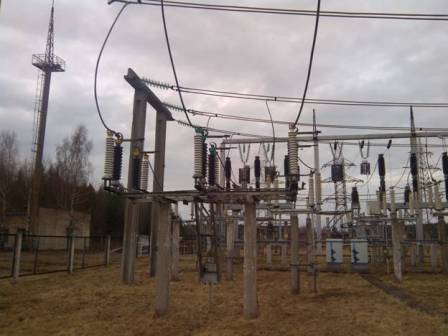Categories: Featured Articles » About electricians and not only
Number of views: 61523
Comments on the article: 14
Profession Electrician relay protection and automation
Specialty electrician. Relay protection, automation, measurement service. Features and requirements
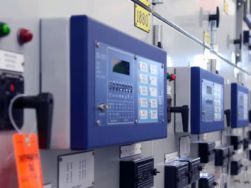 There is such a profession in the energy sector: to protect people and equipment from short circuits and other malfunctions in the electrical circuit. The work is complex, highly paid, prestigious.
There is such a profession in the energy sector: to protect people and equipment from short circuits and other malfunctions in the electrical circuit. The work is complex, highly paid, prestigious.
Only persistent, purposeful and competent people master this profession. They are usually called by profession - relay workers. This is explained by the fact that for a very long time the relay-based element base is used in the algorithm of protection and automation circuits, although recently microprocessor devices using computer technologies have begun to appear in large quantities.
Just want to give an example from the life of the substation team with equipment operating under a voltage of 330 kilovolts.
This is how its modern three-phase circuit breaker 330 kV looks.
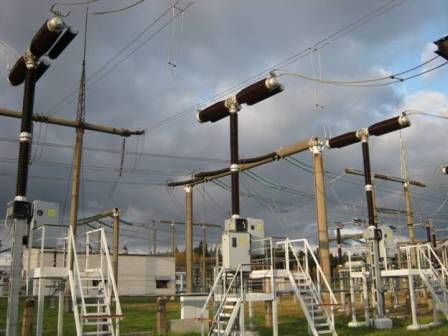
And this is her linear disconnector.
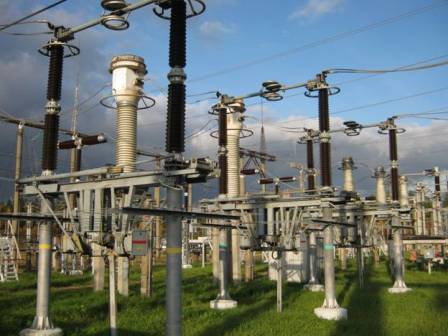
Each VL-330 is switched with autotransformers at substations. Three autotransformers of 330/110/10 kV operate on the open switchgear (ORU) of this substation.
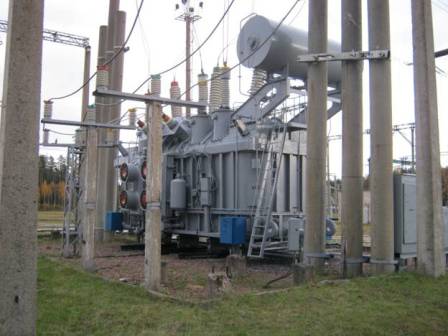
Protection, control, automation and other functions of the electrical circuit operation electricians of relay protection and automation service (RPA).
Their equipment is placed on panels located in special rooms - three relay rooms, comparable in size to the sports ground. Old panels have been working for more than 30 years, in front they look like this.
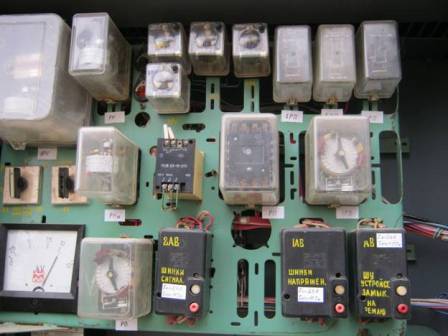
Here is their typical rear view.
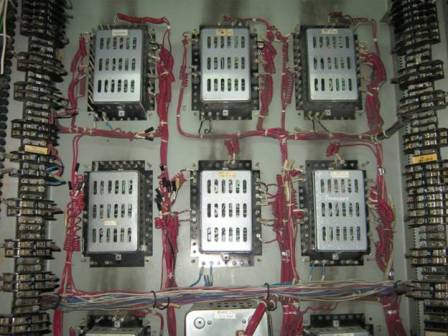
Modern equipment in front.
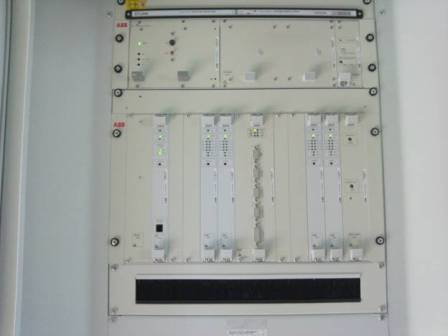
Her photo is from the back.
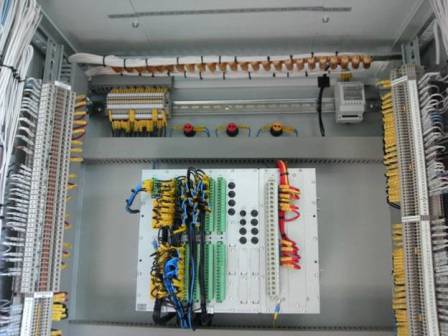
How relays cope with their duties can be learned from the sad example of an accident. A team of repair personnel under the supervision of the manufacturer of the work (an electric fitter with the fifth category and the fourth group for electrical safety) worked at the outdoor switchgear-110, performing preventive maintenance of the disconnected disconnector.
Neighboring equipment was fenced, under voltage of 110 kV.
During the restoration of the color marking of the phases on the supporting insulators, the manufacturer of the work (with extensive experience and experience) mistakenly touched a brush to the live phase insulator. The safe distance to the live part was broken, an electric discharge passed through his body through the air along the way: his right hand and both legs.
The clothes instantly ignited, and the electric fitter was dropped from a height by a charge impulse. He was quickly provided with first aid, a brigade machine was taken to the hospital. After a long course of treatment, he returned to the substation. He worked for another five years, until irreversible processes in the body began from the resulting electrical injury.
The passage of electric current (0.08 sec) through his body was limited by the high-speed differential protection of tires with braking (DZShT), which automatically allowed the passage of only four harmonics. A faster shutdown is not possible.
The electrician of the relay protection service of the 7th category was engaged in the adjustment and operation of the DZShT. The automatic recording of the recording devices, which were serviced by another specialist relay with the 4th category, helped to analyze the shutdown, to evaluate the response times of the protections.
Thanks to the competent performance of the duties entrusted, the electricians of the relay protection and automation saved the life of a person, prevented the consequences of the short circuit.
Methods for obtaining the profession of electrician of relay protection and automation
To perform skilled work in protection and automation devices, high technical knowledge is required from higher education institutions.
But it is possible to acquire the specialty of an electrician of relay protection and automation even after graduating from a technical school, which gives the right to go to work in energy organizations as electricians. The personnel department of the enterprise will pay attention to:
-
health status;
-
recommendations, characteristics from places of study or past work;
-
assigned specialty by the training center, received rank.
A RPA specialist needs a physically strong body and good eyesight:
-
transformer loading devices, portable tools weigh a lot. They have to be constantly moved;
-
relay contacts, microcircuits, semiconductor elements very small, they need to be inspected all the time, and the lighting conditions are often poor.
A lot of work is related to reading technical literature, working out electrical circuits. The load on eyesight is added by computer programs that must be used to test modern complex protections or to evaluate the metrological characteristics of electrical measuring instruments.
If the opinion is positive, the employee of the personnel department directs the applicant for a conversation to the management of the service to form a final opinion. During a personal conversation, questions related to upcoming activities will be asked, and immediate tasks will be clarified. But you should not count on getting a high rank or even the one that was assigned by the training center.
The specialty will have to be mastered from the lowest level, each time to confirm it with high-quality everyday work and timely passing exams, which are common in the power system: too responsible work.
Here you will have to study from the very beginning, and not only at the periodic refresher courses of the enterprise, but mainly independently during the daily work.
Production conditions
Electricians of relay protection and automation work, as a rule, as part of a team under the guidance and supervision of the manufacturer of works - an experienced mentor. Sole work is entrusted only to highly qualified specialists in individual cases.
Energy enterprises regime. They have a clear work schedule, control, supervision. All activities are planned, taken into account, documented by the paintings of workers. For all equipment inspections, protocols are drawn up and passports are filled out, which are stored in the paperwork.
Distribution of duties
In the relay protection service, teams are assigned to certain substations with different operating voltages. At a large substation, as in the above photos, a stationary brigade works with a limited number of outgoing places: about 10 substations 110/35/10 kV.
Other specialists constantly travel on business trips within the district in brigade cars, live in hotels.
Relay protection devices are located on:
-
outdoors (current, voltage, terminal blocks, distribution cabinets);
-
in closed stationary rooms made of brick, concrete slabs or metal sheets.
Work at height
To maintain the equipment you have to climb to a height of about five meters, most often with the help of ladders. This requires good physical preparation: it is necessary to make considerable efforts to unscrew and tighten the fixing screws, raise the cables and wires to a height, and conduct electrical measurements. Work can be complicated by wind, rain, snowfall, cold, darkness, the blinding light of the sun.
Basements and basements
Cable communications pass through trays in the open air, can be placed in basements or semi-basements, buried in the ground. Under certain circumstances, they have to shift or clean.
Duty & Emergency
In addition to the daily tasks of scheduled maintenance of electrical installations, RPA electricians can be involved in emergency work on weekends or at night.This happens especially often in the winter, when the on-site brigades cannot resolve the arising failures on their own.
To this end, from among the trained specialists, the head of the service monthly draws up a duty schedule for weekends and holidays. At this time, the employee is obliged to indicate to the dispatcher his address and phone number, to be ready to leave for work at the first signal.
Responsibility
An electrician of relay protection and automation, like any person, can be mistaken. This is important to understand. Therefore, among these workers, two principles apply:
1. do no harm;
2. Never consider yourself smarter than your predecessor. If you see a mistake, then do not rush to correct it immediately, but specify: why this is done. Most likely, you yourself could not understand or take into account something.
Relay Mistakes
Two electricians performed professional recovery of differential-phase protection DFZ-201 VL-110 kV and simultaneously outputd discrete signals from its output contacts to a microprocessor recorder. The work was designed for the whole week and was almost completed on Friday before lunch.
After the break, the relays returned to their workplace to complete the verification of the algorithms. One of them went to the registrar, having started to prepare him for viewing signals, and the second went to the DFZ panel.
Note! Both worked on the panel for a week, on it is a large green poster "Work here!" Hanging on it, warnings are displayed on the adjacent panels: "Stop, tension."
For some reason, an experienced electrician of the 7th category was distracted from his duties, went to a neighboring similar panel of another connection that is in operation, removed the cover from the output protection relay and worked it manually, thus disconnecting electricity from a large regional center. I didn’t explain how I did this.
This example, like the case of an electrician affected by electricity, indicates that when handling electricity, one should not only be competent, but extremely careful and careful. Even excellent safety knowledge with extensive practical experience does not always preclude personnel errors.
If you are unsure of your abilities, then do not take up work with electricity. It does not forgive mistakes, inept actions and always severely punishes for the slightest mistake.
Brave Alexei Semenovich
See also at i.electricianexp.com
:

